
Wondering what’s the easiest way to break into UX design? A great place to start is with free online courses. They’re one of the most flexible and cost-effective routes to advancing your UX design knowledge, skills, and career.
Committing to design courses can develop your skills and set you up for a thriving career in UX. Whether you’re an absolute novice or an experienced designer—there’s always room to develop your UX knowledge.
If you’re ready to learn UX design and expand your skill set, we’ve narrowed down the go-to online courses for you.
Why start with a free course instead of paying for a degree? Degrees, though beneficial, are not for everyone. If you’re limited on time, want to work on just a few skills, or prefer a flexible learning environment, a degree might not be your best bet.
This is where free courses come in.
With greater flexibility and control over your learning, UX design courses give you the education you need to make headway in this industry. You get to decide your pace and choose your own schedule while building your skills.
These courses are also a great way to begin learning about UX without the price tag of a university degree. If you’re uncertain, a free UX course can help you get a better idea of whether you see a future in UX—without spending thousands.
Plus, you might just find that flexible courses are a better option for you—free or not. You can always enroll in a degree program following a free course, but you could also explore other options—such as an online learning platform or bootcamp. You can even obtain industry-recognized certifications online—it’s not just university degrees that employers are after!
Now that you know why free courses are a great learning step, let’s consider what you should look out for when comparing options.
What to look out for in a free UX design course
You’ll find many free UX design courses, but choosing the right one depends on your specific needs.
Here’s what you should look for in a user experience design course:
- Flexible: when choosing a free UX design course, consider if it offers you the flexibility to learn at your own pace. If you’ve got other responsibilities, a flexible course gives you the freedom to choose when you learn.
- Length: courses can be as short as a few hours or as long as a few months. Your choice depends on how much time you can commit to learning.
- Challenging and engaging: make sure to find a UX course that suits your skill and knowledge level. You also want to consider whether it can continue to challenge and engage you as you progress—does it have beginner, intermediate, and expert content and resources?
- Up-to-date: you want a course that’s consistently improved in line with the fast-evolving UX landscape.
- Certifications: find a course that provides official certifications following course completion. Although many courses offer certifications, they’re not always professionally recognized. Courses should offer a way to validate your knowledge and make you more credible as a designer.
1. Uxcel’s UX design courses: best for learning and certifying UX skills

Uxcel is an online learning platform that offers UX design courses and career paths for all levels — whether you’re a beginner or an expert. With Uxcel’s interactive and engaging courses, lessons, and challenges, learners can dive deeper into various UX topics and methodologies. It’s a flexible approach to learning about UX that enables you to work independently and receive professional certifications in many UX disciplines.
Top Features
Here’s what Uxcel offers designers:
- Interactive courses and lessons: Uxcel’s catalog of online lessons and courses covers a wide variety of popular and lesser-known UX topics. It’s frequently updated with new courses and materials to ensure you get the most up-to-date UX info available.
- UX Assessments: you can test and assess UX skills you have learned with interactive skill tests that show you how you stack up against designers from around the world.
- UX Challenges: real-world exercises are necessary to understand how the UX industry works—and also help build a strong portfolio. With Uxcel, designers can apply design skills to UX challenges and get professional feedback.
- Professional UX Certifications: get industry-recognized UX certifications to validate role-specific learning and knowledge.
- UX Training: take specialized UX training courses to get you ready to earn your certifications and enter the UX job market.
- Arcade: make learning fun with UX-themed games in the UX arcade.
Course highlights
Uxcel’s courses are divided into beginner, intermediate, and advanced categories. Topics include:
- UX design Foundations course
- Design Terminology course
- UI Components course
- User Research course
- Wireframing course
- CSS and HTML for Designers courses
- Design Accessibility course
- Design Composition course
- Enhancing UX workflow with AI couse
- AI fundamentals for UX course
Uxcel’s free to start online courses will introduce you to beginner and advanced UX design principles and ensure you’re ready to tackle the challenges that come up in the industry.
Build your design skills each day with our UX design courses. Sign Up for free today.
2. Free Short UX Course: best for a brief introduction to UX Design
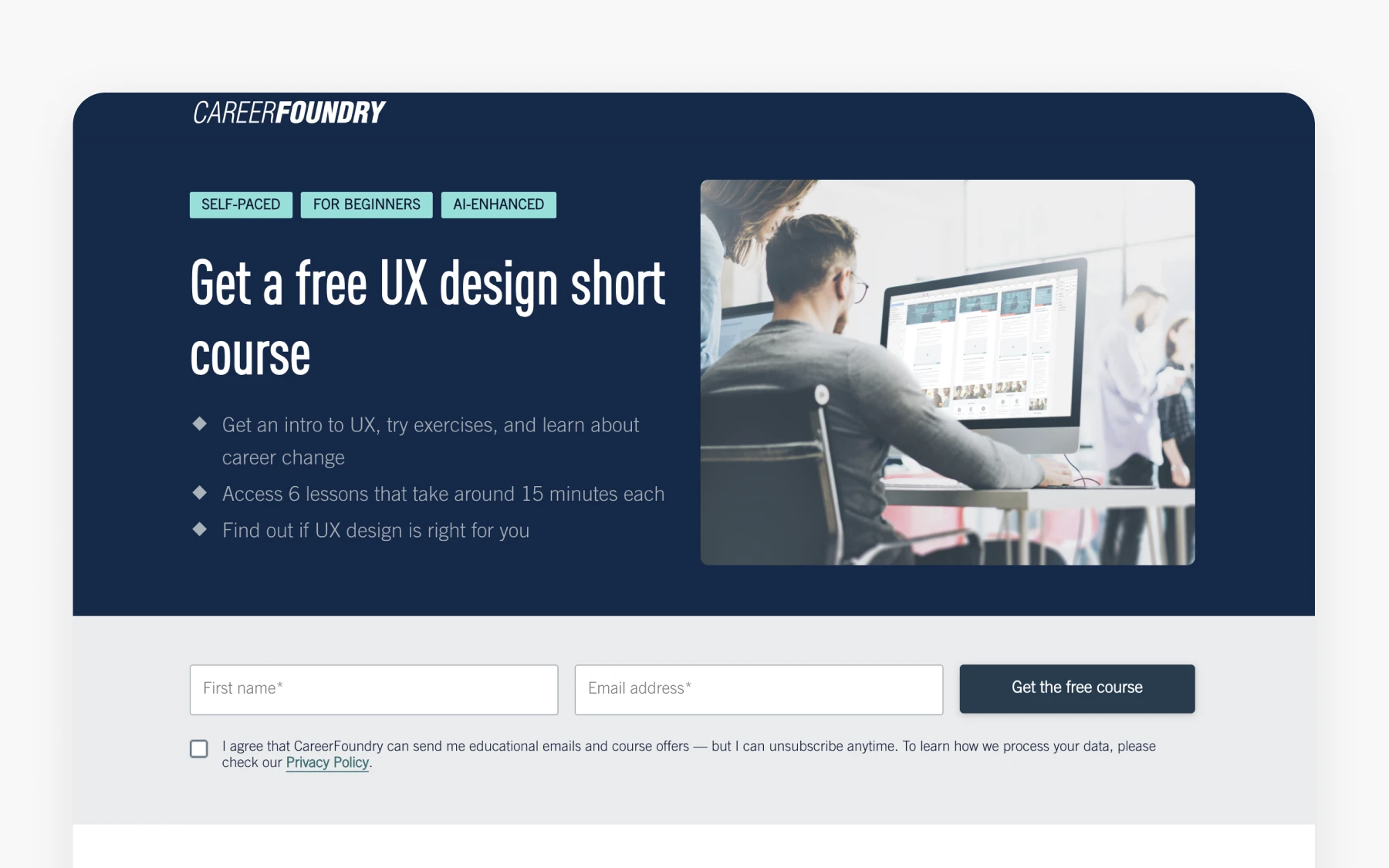
CareerFoundry’s free UX design course is a short, beginner-friendly course that introduces aspiring designers to user experience design. Through its certificate program, you can explore the foundations of UX at your own pace and find out whether UX design is the right career path for you.
Top Features
Here’s what CareerFoundry’s UX design course offers:
- Video learning: each lesson starts with a video to settle you into the topic.
- Self-paced: flexible and self-paced, each design tutorial only takes 15 minutes to complete.
- Brief hands-on exercises: build your skills by taking six brief but content-rich UX design lessons every day.
Course highlights
The course covers introductory topics such as:
- What is UX Design
- The design process
- Career paths to take in UX
- Fundamental UX skills
- Tips on building a stellar portfolio
With CareerFoundry’s free course, you can get a glimpse into the world of UX and decide if it interests you.
3. UX Design Course, LinkedIn: best for earning academic credit

LinkedIn Learning offers a 30-day cost-free trial and promises to teach designers modern design principles and user-centered design. With this UX course, you’ll learn the foundations of UX—including research and analysis, creating user journeys, determining user needs, and more.
Top Features
LinkedIn’s UX course helps designers learn:
- Career-oriented lessons: learn about the disciplines of UX design and figure out they resonate with you, your strengths, and your passions.
- Academic credits: earn academic credit for select partner universities around the world to continue your learning with a UX degree.
- Portfolio building: enhance their UX design portfolios through interactive projects.
Course highlights
The course covers design fundamentals such as:
- Career planning in UX
- UX overview
- Data analysis
- Persona and storyboard creation
- Wireframing and prototyping
- Implementation planning
- Sketching
With Linkedin Learning’s beginner-friendly UX design course, to-be designers can start their design career.
4. Product Design Course, Google: best for learning via Google’s Design Sprints
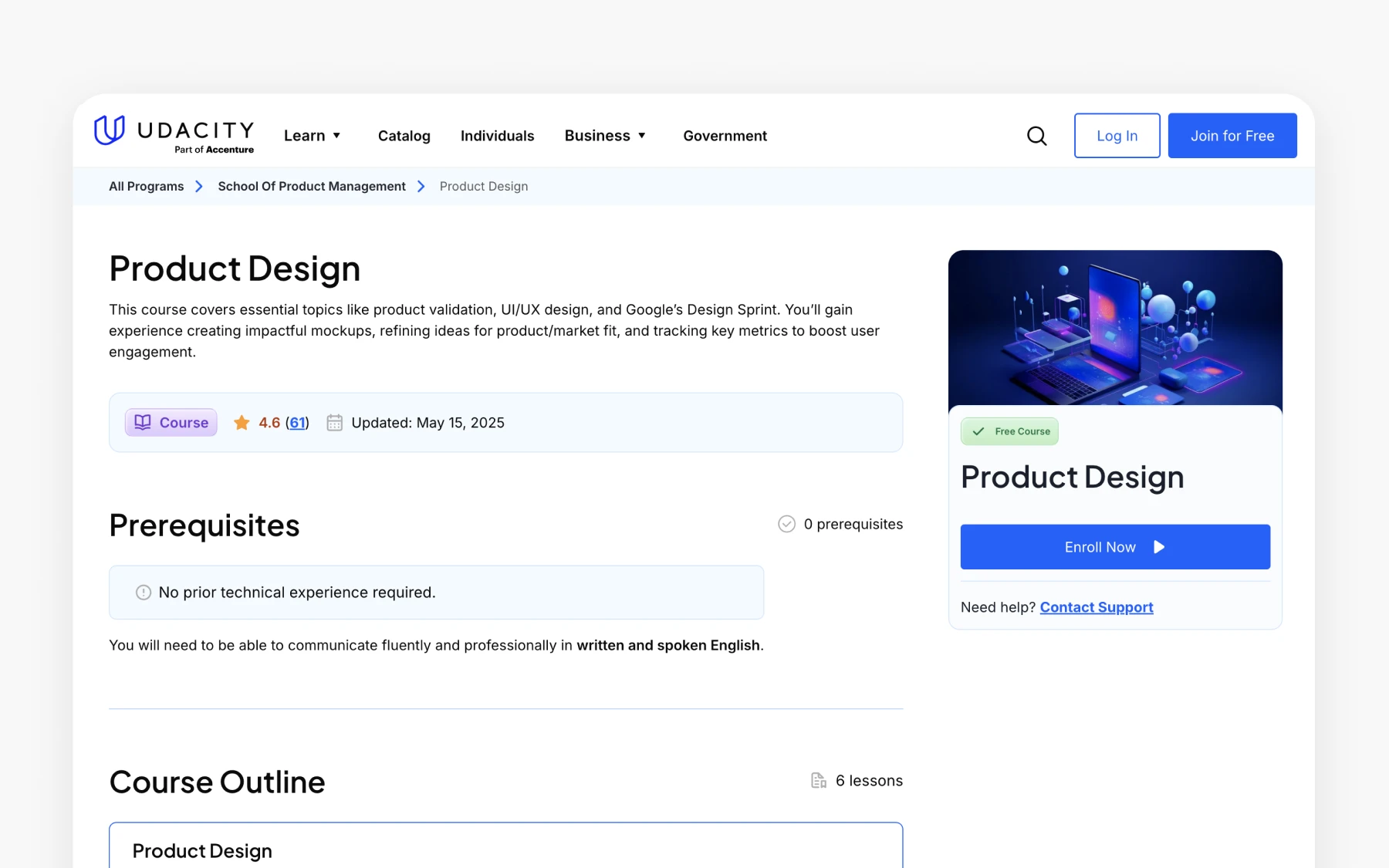
Google’s Product Design course helps designers develop, test, and transform their ideas into a product that can be used in business. In this course, learners explore and learn key UI/UX practices, create user flows and wireframes, understand how to validate a product, and gain insights into Google’s design sprint process.
Top Features
Google’s product design course offers
- Instructor-led lessons: learn from instructor-led lessons and case studies.
- Interactive quizzes: test what you’ve learned with interactive quizzes and assessments.
- Self-paced learning: go about learning at your own pace.
- Nanodegree certificate: accelerate your career with a specialized certificate.
Course highlights
The course covers product creation and UI UX elements. These include:
- Ideation and validation
- UI UX
- Design sprint
- Key metrics
Google’s Product Design will help you build a portfolio that shows off how well you use user research to create transformative designs.
5. Introduction to User Experience Principles and Processes, University of Michigan: best for UX research principles
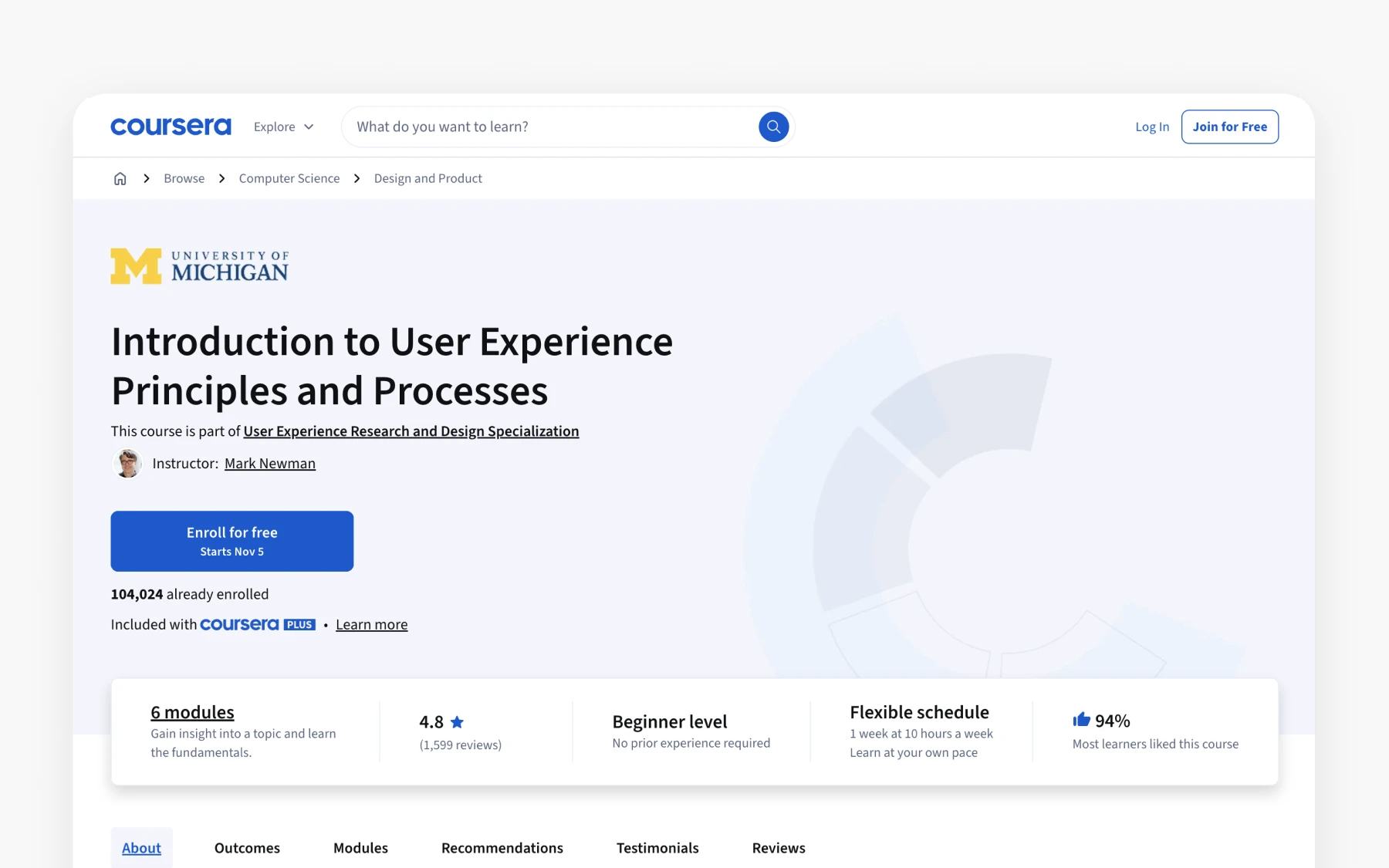
This course by the University of Michigan on Coursera is for beginners and intermediate-level designers who want to learn the technicalities of UX design. From conducting user interviews to wireframing, prototyping, and understanding user needs, the course focuses on integral aspects of UX research.
Top Features
The University of Michigan’s design course offers
- University module: get a taste of what it’s like to learn UX in an academic setting with this course offered by UMichigan.
- Certification: earn a shareable certificate you can use to validate your learning upon completion.
- Downloadable content: learn offline by downloading the course content to your devices.
Course highlights
Here’s what you’ll learn:
- UX research and design skills
- Discovering and assessing user needs
- Conducting micro-usability test
- Using user-centered focus in the design process
- Impact of human behavior on designs
- Critiquing and designing interactive systems
This course by the University of Michigan will help you build a research-focused portfolio that highlights your UX skills and knowledge.
6. Intro to User Experience Design by Georgia Tech: best for conceptual learning of UX Design

In just six hours, Georgia Tech’s Intro to UX design allows novice designers to discover, evaluate, and learn UX technique basics—such as the four-step user interface design cycle. The course aims to introduce learners to the study of user requirements and goals and how to use them to design interfaces.
Top Features
Georgia Tech’s UX course offers learners:
- Simplified learning: learn how to evaluate and design user-centric interfaces in a simple, efficient manner.
- Self-paced classes: take the course at your own pace and pick up where you left off with self-paced lessons.
- Multiple languages: learn about UX design in your mother tongue—the course is offered in Arabic, French, Portuguese (European), Chinese (Simplified), Italian, Vietnamese, German, Russian, English, and Spanish.
Course highlights
The course helps novices learn more about UX design by focusing on:
- UX overview
- Requirement gathering
- Designing alternatives
- Prototyping
- Evaluations
Online and short, beginners who wish to learn UX design basics can benefit from Georgia Tech’s Introduction to User Design.
7. UX Fundamentals, Gymnasium: best for learning user-centric web design and development
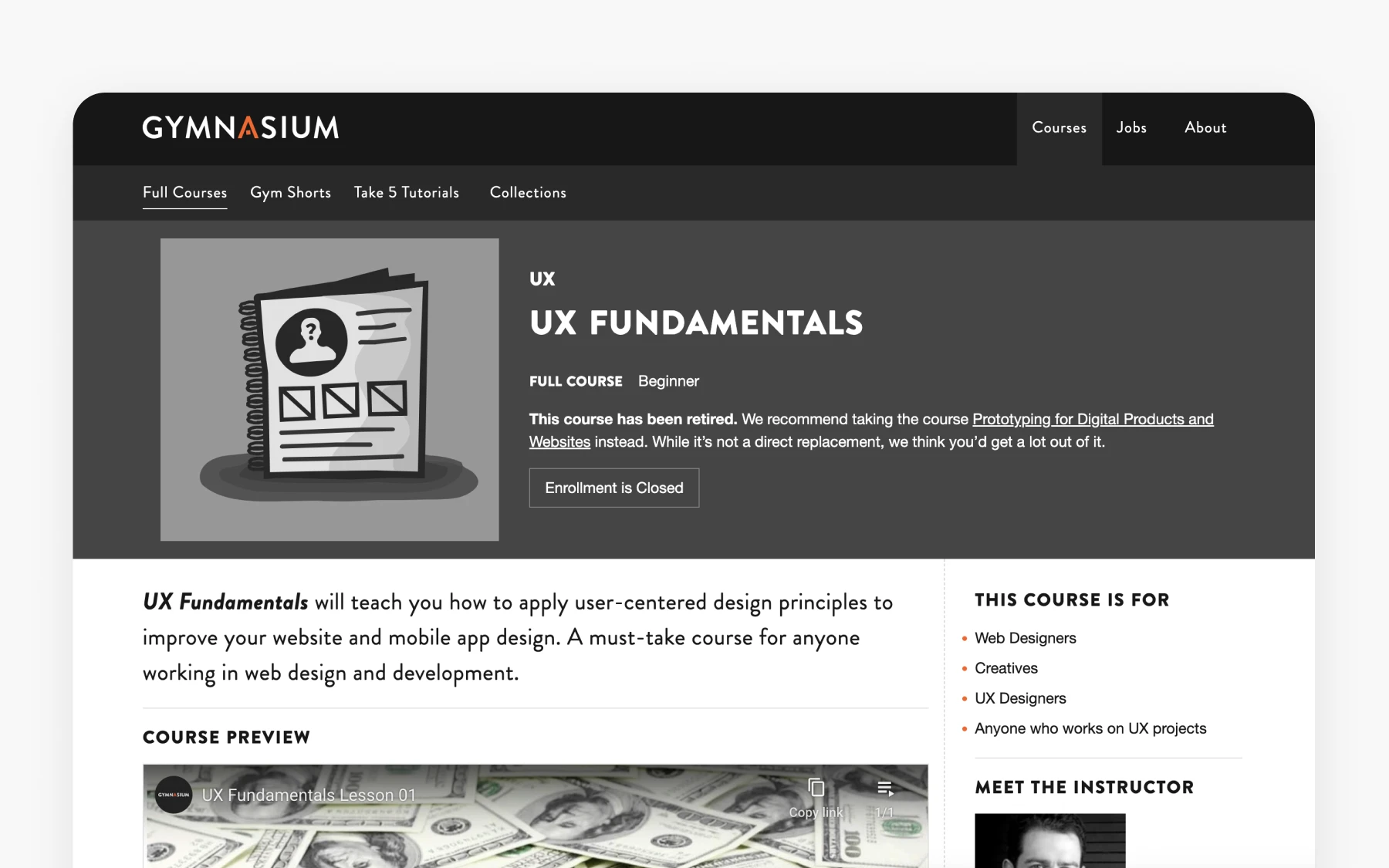
UX Fundamentals by Gymnasium delves into user-centered design techniques to help web designers and UX designers improve websites and mobile apps. Through the free course, individuals will learn how to conduct user research, create personas, make wireframes and prototypes, organize content, and more, according to user needs.
Top Features
Gymnasium’s UX Fundamentals provide designers with:
- Flexible lessons: the course encourages self-learning through six lessons with short videos, homework assignments, and quizzes
- Online forum: you can access an online forum to interact and get feedback from other students and teaching assistants.
- Certification: pass the final exam with an 85% or higher and earn a professional UX certificate.
Course highlights
This UX design course teaches:
- UX fundamentals
- Wireframing and prototyping
- Understanding the user
- UX writing
- Best practices in UX
This course is for advanced-level designers who have prior knowledge of graphic/web design and understanding of Photoshop, Illustrator, or In Design.
8. A Taste of UX Writing, UX Writing Hub: best for UX writing

UX Writing Hub’s UX design course is a great option for beginners and professionals alike. The course consists of eight modules, each with in-depth UX writing lessons, quizzes, and final exercises.
Top Features
Here’s what A Taste of UX Writing features:
- Self-paced learning: the self-paced course encourages learning at your own schedule and comfort.
- In-depth coverage: with this UX course, you will cover the ins and out of UX writing, including user journeys, microcopy, content guide, and larger UX design processes.
- Real-world overview: the course also provides a real-world look at what it takes to be a UX writer.
Course highlights
The UX course covers:
- The cost of Poor UX design
- Microcopy
- Psychology and UX
- Testing and research methods
- User journeys
- Content style guides
Writers who want to learn about UX writing will find A Taste of UX Writing very beneficial.
9. UI/UX Design Specialization, CalArts, Coursera: best for graphic designers

This free course offered by CalArts, requires a five hour commitment every week for about four months. Designers will learn through hands-on projects that allow self-paced learning of UI and UX fundamentals. With the free version, you can only access course content. To unlock quizzes, assignments, and peer feedback, you’ll need the paid version.
Top Features
Here’s what you can expect from this UX design course by CalArts:
- Applied learning: The course
- Suite of UX tools: learners get one month’s free access to Optimal Workshop’s suite of UX tools—such as usability and prototyping tools.
- Hands-on projects: each course in the specialization includes hands-on projects that need to be completed to earn the certificate.
- Certification: with completing each lesson in the course, learners get a certificate they can share.
Course highlights
The UI UX course teaches:
- Visual design
- UX fundamentals
- Web design
- Wireframes and prototypes
Graphic designers who want to explore UX/UI design will find this UI UX Specialization course a great help.
10. Design Course, Hack Design: best for consistent and varied learning
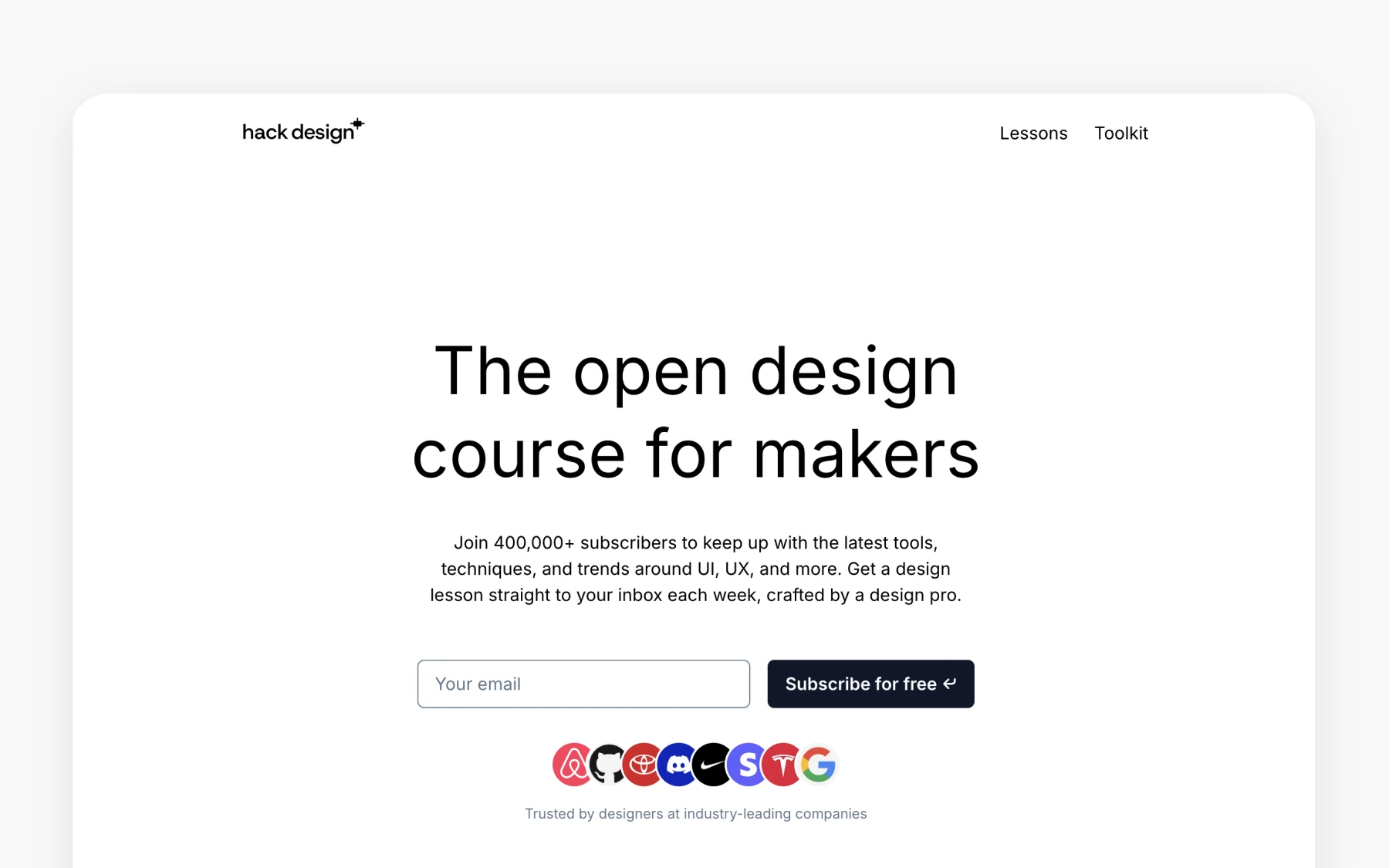
Hack Design’s Design Course helps UX designers get up-to-date with the fast-paced UX and web design industry. Students are emailed weekly lessons that include intros to various design tools, techniques, UX resources, and anything else that can help enhance their skills.
Top Features
Design Course by Hack Design offers:
- Weekly lessons: get UX lessons delivered to your inbox for a consistent and spread-out approach to learning UX.
- Wide-ranging topics: the course covers a range of topics, including front-end design, user interface design, typography, and wireframing, among others.
- Industry experts: lessons curated and led by industry experts and professionals.
Course highlights
The UX course covers:
- Typography
- User experience
- User interface
- Graphic design principles
- Interaction design
- Product design
- And more
The Design Course by Hack Design is great for designers in the industry who want to keep up with the current trends.
Choosing the right UX design free course for your budget and knowledge
Finding the right UX course for you depends on your flexibility, needs, goals, and more. One thing’s for sure, though—you’re not short of options.
If you’re looking for high-quality courses and lessons that allow you to learn at your own pace, try Uxcel. It’s ideal for all levels and enables you to learn, assess, and certify your UX skills.
Sign up free today to start upskilling your UX skills and levelling up your career.




